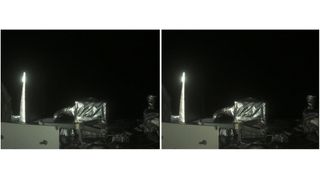OSIRIS-APEX emerged “unscathed” from its closest brush ever with our sun on January 2, scientists announced on Tuesday (May 28).
The probe, originally known as OSIRIS-RExcompleted its sample return mission to asteroid Bennu and is now heading for the space rock Apophis on an extended mission. This new mission calls for OSIRIS-APEX to slide 25 million miles (40 million kilometers) closer to the sun than it was. designed to act. Scientists think that several such close passes are necessary for the probe to enter a path to reach Apophis in 2029.
OSIRIS-APEX is in an elliptical orbit around our sun, which puts it at its closest point to the star once every nine months. It is the first of its kind narrow approach it happened on January 2nd. To prepare for the intense burst of radiation, in early December the mission team inserted into one of OSIRIS-APEX’s two solar arrays such that it cast a shadow over the probe’s most sensitive instrumentswhile the second panel faced the sun to power the spacecraft.
Connected: How NASA’s OSIRIS-REx mission will help protect Earth against asteroid Bennu and its flyby in 2182

This piece of creative engineering protected the spacecraft during its perilously close approach to the sun, just as computer simulations had previously predicted, the mission team split this week into a NASA statement.
“It’s phenomenal how well our spacecraft configuration protected OSIRIS-APEX, so I’m really encouraged by this first near-perihelion pass,” said Ron Mink, mission systems engineer for OSIRIS-APEX at the Space Flight Center. NASA’s Goddard in Maryland.
Telemetry data downloaded from the spacecraft in mid-March reassured scientists of its good health. By early April, the probe had moved far enough from the sun to resume normal operations, according to a NASA statement.
Scientists and engineers were also pleasantly surprised to notice that an onboard camera performed even better than expected after being exposed to high temperatures during the encounter. MapCam, a medium-range camera that has previously mapped Bennu in color and will also map Apophis, has seen a 70% reduction in heavy white spots called hot pixels since April last year, the time the last time the camera was tested.
Hot pixels occur due to prolonged exposure to solar radiation and are a common problem for cameras in space. While they are usually resolved by controlled heat using onboard heaters, OSIRIS-APEX’s camera reset naturally, thanks to increased heat from the close encounter with the sun, the scientists said.
While mission team members are relieved that OSIRIS-APEX is safe after its first close approach to the sun, they noted that it is unclear how five more such encounters might affect the probe and its instruments. .
The next closest approach to the sun is scheduled for Sept. 1, when the spacecraft will again pass within 46.5 million miles (74.8 million km) of the sun’s surface, well within the orbit of Venus and well beyond the probe’s originally anticipated operational limits. .
